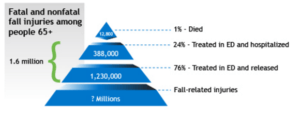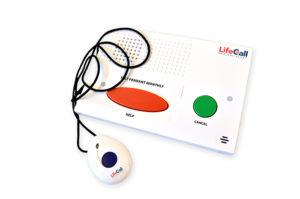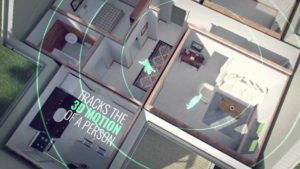Improving care for those who cared for us
Falls
By 2050, the 65+ population is expected to grow to 83+ million (double what it was in 2012)1. We all know and don’t enjoy thinking about it, but most of our parents are either in this category or soon to be. There are a variety of ailments that come with age such as diabetes, cardiovascular disease, cancer, and Alzheimer. One particular phenomenon that the digital transformation age can uniquely help with is falls among the elderly population.
The likelihood of falling proportionally increases with age and is the cause of 87% of all fractures among this population2. After following, the time spent immobile causes muscle breakdown, dehydration, pressure sores, and hypothermia among other complications. Furthermore, receiving help after a fall dramatically improve the likelihood of survival for the individual2.
Remote Monitoring – wearable
While completely preventing falls among the elderly may be impossible, we can still develop solutions to ensure that those who do receive necessary care in a timely fashion. Many companies have taken note and the industry for remote monitoring tools for the elderly is expected to grow at a 14% CAGR and reach $1 billion in 20203. This is driven by the push among providers to improve the quality of patient care away from the expensive walls of a hospital and improve the quality of life for patients.
One of the most common solutions we see are the neck pendants that are advertised on late-night infomercials. One of these products, Lifecall FallAlert, constantly monitors an individual’s motion and movement to distinguish between normal movement and a fall. When detected the unit will call an emergency Response Center to establish a line of communication4. There is no shortage of wearable devices for the elderly population. Wearables have extended to all sorts of attire including belts, insoles for shoes, and bracelets5.
While wearable detection devices may functionally work, there are still flaws from the perspective of human behavior and adherence. The technology only works if individuals use it. I don’t know about you, but I can’t say I would enjoy wearing a neck pendant everywhere I went. Why should we expect any different from the elderly population? Fitbit, as trendy as they may look, have experience strong sales but 1/3 of users abandon use after 6 months6. According to a study by PWC in 2014, only 13% of individuals are interested in buying a human tracking device7.
Remote Monitoring – IoT
Emerald, a start-up out of MIT, is developing a solution that detects fall wirelessly without the use of a wearable device. The start-up has developed a router that sends and detects radio signals8. Changes in the radio signals as it interacts with the human body within a living quarter can detect falls without the need for an obtrusive piece of apparel. In addition to detecting falls, the device can help monitor breathing patterns and heart rates of the patient. I can imagine that improved hardware will lead to richer data to continuously improve the insights we garner as we track the physiological patterns of patients.
Surely the technology will continue to evolve and perhaps it could evolve our definition of what digital health means. As trendy (or not) Google Glass may have been, perhaps we don’t always need to wear our digital devices.
While there is no perfect substitute for being physically there for our aging populations, digital transformation can help us feel more connected and protective as we pursue aspirations that may take us geographically further. The Internet of Things (IoT) can be used for more than just controlling the lights, music, and appliances in our homes. I believe that there is significant potential for monitoring the health of patients without inhibiting quality of life.
Word count: 626






Great post Philip. We purchased a wearable device for my grandmother several years ago and I find it not only helps getting care rapidly in the case of a fall, but it also gives peace of mind to members of the family. What we purchased, given what was available at the time, was a bracelet that would act as a fall detector but also a cellphone in case of a fall, so that communication would be possible with the people sending the care givers. I fully agree with you that response time is very important in those instances, and the issue the IoT option you are describing solves, is the situation where a person falls and does not have the ability to communicate after a fall, as it speeds up the care giving process if monitoring can be done through the system. I fully agree that in this case digitization can go as far as saving lives, and this is a great example of how it disrupts an industry in a very positive way.
What an important type of digitization. Falls are incredibly dangerous for the elderly, many resulting in serious injuries or death within several years. My primary concern is the cost of this new technology. A wearable device can be be made easily accessible to the masses. Can this highly technical router be made, maintained, and monitored affordably? (I am remembering Becky’s $18,000 meatball) I believe that it could be beneficial for Emerald to start talking to insurance companies early to determine if they can establish relationships. It appears like there is significant potential value in this new digital technology and costs will be an important factor in determining whether it can be widely disseminated.
Great post Phillip. Those late night informercials were ringing in my head as I read your post. How the new technology developed out of MIT monitors heart rate via wireless technology is beyond me but it’s really impressive. Now, the elderly are mostly home-bound, but I’m sure that most of them like to walk around the house or relax in the backyard. If coverage for the wireless technology is not broad enough, the applicability of this application may be limited. Other instances where the elderly are away from home, but not in plain sight of a potential helper could also present a minor detraction for this technology.
So interesting! I wonder simultaneously what this data could be used for (constant data on heart rate, etc. seems like it could have tremendous applications in health care, insurance, etc.) and the extent to which people will feel as though this is overly intrusive, thus preventing further applications. Sensing what is going on in your body at every moment you are home seems like a fairly large step from what most of us are OK with now. I can imagine that this feels different when installing in your elderly grandmother’s apartment, but could our privacy concerns prevent this from taking off?
I’m loving the heart behind this post Phil – thanks for bringing this company to light, since I may be looking for a solution in the future for my parents. I completely agree that there are flaws to the wearables model, but I also think there are risks with Emerald’s idea. Having radio waves emanating from a device in your home detect things as small and internal as breathing and heart rate sounds invasive. Even if it’s 100% safe (is it??), can you imagine what an older population thinks about it? Maybe another step they can take is manage the message around what guarantees it offers around safety.